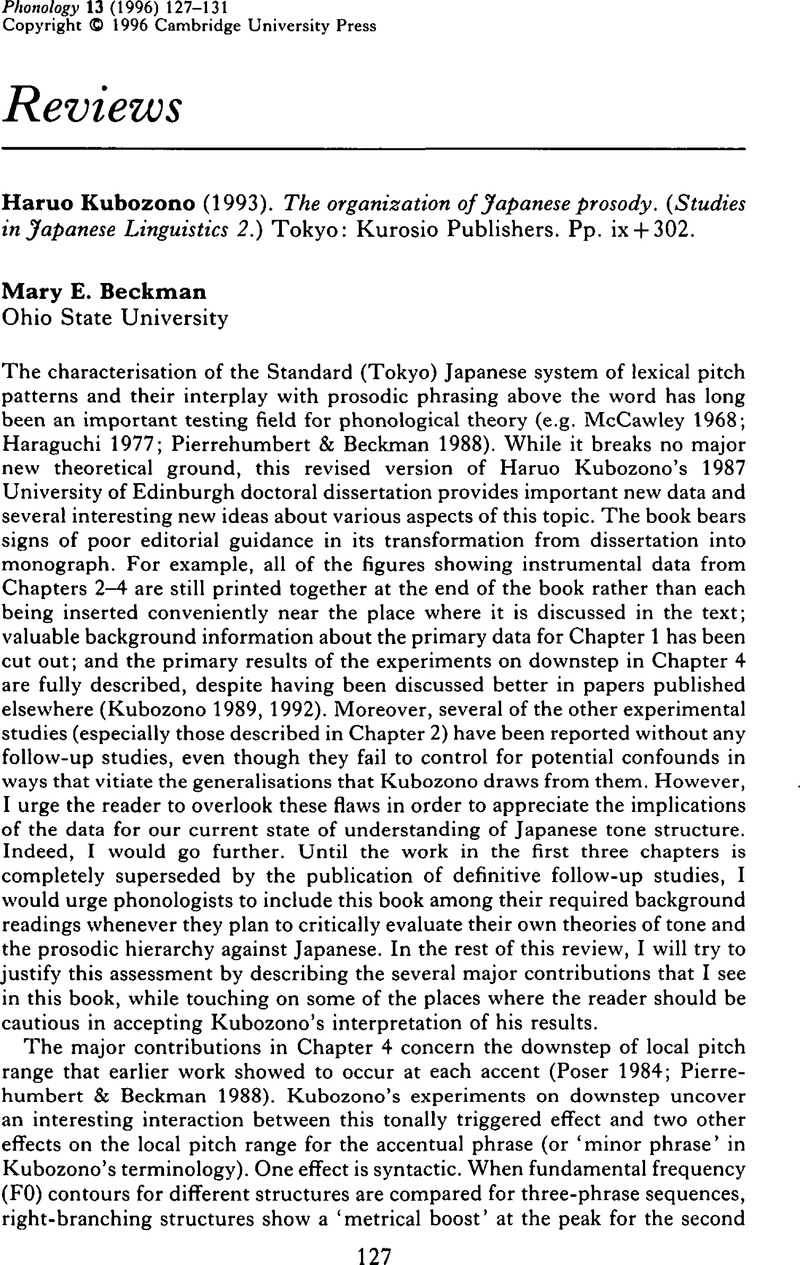No CrossRef data available.
Article contents
Haruo Kubozono (1993). The organization of Japanese prosody. (Studies in Japanese Linguistics 2.)Tokyo: Kurosio Publishers. Pp. ix + 302.
Published online by Cambridge University Press: 20 October 2008
Abstract
An abstract is not available for this content so a preview has been provided. Please use the Get access link above for information on how to access this content.

- Type
- Review
- Information
- Copyright
- Copyright © Cambridge University Press 1996
References
Connell, B. & Arvaniti, A. (eds.) (1995). Phonology and phonetic evidence: papers in laboratory phonology IV. Cambridge: Cambridge University Press.Google Scholar
Connell, B. & Ladd, D. R. (1990). Aspects of pitch realisation in Yoruba. Phonology 7. 1–29.Google Scholar
Docherty, G. J. & Ladd, D. R. (eds.) (1992) Papers in laboratory phonology II: gesture, segment, prosody. Cambridge: Cambridge University Press.Google Scholar
Gandour, J., Potisuk, S. & Dechongkit, S. (1994). Tonal coarticulation in Thai. JPh 22. 477–492.Google Scholar
Kubozono, H. (1989). Syntactic and rhythmic effects on downstep in Japanese. Phonology 6. 39–67.Google Scholar
Kubozono, H. (1992). Modeling syntactic effects on downstep in Japanese. In Docherty & Ladd (1992). 368–387.Google Scholar
Kubozono, H. (1994). Syllable and accent in Japanese: evidence from loanword phonology. Paper presented at TREND II (Trilateral Weekend Phonology Meeting), University of California, Berkeley.Google Scholar
Kubozono, H. (1995). Perceptual evidence for the mora in Japanese. In Connell & Arvaniti (1995). 141–156.Google Scholar
McCawley, J. D. (1968). The phonological component of a grammar of Japanese. The Hague: Mouton.Google Scholar
Maekawa, K. (1994). Is there ‘dephrasing’ of the accentual phrase? Ohio State University Working Papers in Linguistics 44. 146–165.Google Scholar
Nolan, F. (1992). The descriptive role of segments: evidence from assimilation. In Docherty & Ladd (1992). 261–280.Google Scholar
Peng, S. (1994). Effects of prosodic position and tonal context on Taiwanese tones. Ohio State University Working Papers in Linguistics 44. 166–190.Google Scholar
Pierrehumbert, J. & Beckman, M. E. (1988). Japanese tone structure. Cambridge, Mass.: MIT Press.Google Scholar
Poser, W. J. (1984). The phonetics and phonology of tone and intonation in Japanese. PhD dissertation, MIT.Google Scholar
Sagisaka, Y. & Sato, H. (1983). Secondary accent analysis in Japanese stem-affix concatenations. Tokyo: Acoustical Society of Japan.Google Scholar
Scobbie, J. M. (1995). What do we do when phonology is powerful enough to imitate phonetics? Comments on Zsiga. In Connell & Arvaniti (1995). 303–314.CrossRefGoogle Scholar
Zsiga, E. C. (1995). An acoustic and electropalatographic study of lexical and postlexical palatalization in American English. In Connell & Arvaniti (1995). 282–302.Google Scholar




